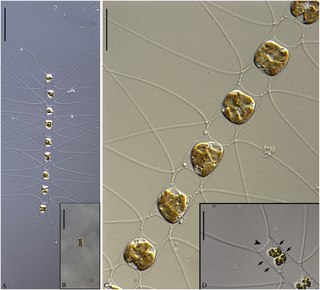
A diatom is any member of a large group comprising several genera of algae, specifically microalgae, found in the oceans, waterways and soils of the world. Living diatoms make up a significant portion of the Earth's biomass: they generate about 20 to 50 percent of the oxygen produced on the planet each year, take in over 6.7 billion tonnes of silicon each year from the waters in which they live, and constitute nearly half of the organic material found in the oceans. The shells of dead diatoms can reach as much as a half-mile deep on the ocean floor, and the entire Amazon basin is fertilized annually by 27 million tons of diatom shell dust transported by transatlantic winds from the African Sahara, much of it from the Bodélé Depression, which was once made up of a system of fresh-water lakes.

Bacteriastrum is a genus of diatoms in family Chaetocerotaceae. There are more than 30 described species in genus Bacteriastrum, but many of these are not currently accepted, and new species are still added to the genus. The type species for the genus is Bacteriastrum furcatum Shadbolt.
Hemendrakumar Prithivraj Gandhi was a pioneering Indian phycologist and diatomist. H P Gandhi did his primary and higher secondary schooling at Pratapgarh and obtained his intermediate degree from Agra. Later, he completed his bachelor's degree and Masters in Botany from the Wilson College, Mumbai in 1949, where he specialized in algae under the supervision of leading phycologist Prof. A. Ella Gonzales. Gandhi joined as an assistant lecturer at Karnatak University, Dharwar in July 1949 and very soon he was transferred unceremoniously to M N College, Visnagar in Gujarat, then to I Y College, Bombay, and after another short time period he joined Rajaram College, Kolhapur after which he finally returned to Karnatak College. With the bifurcation of Bombay Presidency, in 1956, Gandhi was again transferred to Gujarat. His keen interest in the subject made him to collect algal samples from all the possible places and habitats during these transfers, tours and botanical excursions. He retired, in the year 1980, from J.J. Science College, Gujarat from the office of Principal
Craspedodiscus elegans is a species of diatoms in the genus Craspedodiscus. It is the type-species in the genus.
Cymbella elegans is a diatom species in the genus Cymbella.
Campylodiscus elegans is a species of diatoms in the family Surirellaceae.
Climacosphenia elegans is a species of marine pennate diatoms in the order Fragilariophyceae.
Craspedoporus elegans is an extinct marine species of diatom from a deposit from Oamaru, Otago, New Zealand.
Coscinodiscus elegans is a species of diatom in the family Coscinodiscaceae. It is found in the Gulf of Mexico.
Cocconeis elegans is a species of diatom. It is found in Sicily.
Corinna is an extinct genus of diatoms of uncertain placement within Bacillariophyceae. C. elegans is from the Cretaceous of Canada.

Chaetoceros elegans is a species of diatom in the family Chaetocerotaceae. According to Li, 2017, the type locality is Dapeng Bay, Guangdong Province, P. R. China.
Cladomphalus elegans is a species of diatom of uncertain affinity. It is found in Jacob Whitman Bailey's collection on a slide with the inscription "Monterey, California; lower stratum".
Amphora elegans is a species of diatoms found in Europe.
Denticula elegans is a species of diatoms in the family Bacillariaceae.
Gomphoneis elegans is a species of diatoms in the family Gomphonemataceae.

Eunotia is a genus of diatoms. They are fresh water diatoms, specifically common in lakes, and they are also common in fossil records, although their siliceous wall design may have been lost and they appear plane, an example is Eunotia tetradon.
Papiliocellulus elegans is a species of diatom.
Surirella elegans is a species of freshwater diatoms in the family Surirellaceae.

DNA barcoding of algae is commonly used for species identification and phylogenetic studies. Algae form a phylogenetically heterogeneous group, meaning that the application of a single universal barcode/marker for species delimitation is unfeasible, thus different markers/barcodes are applied for this aim in different algal groups.




